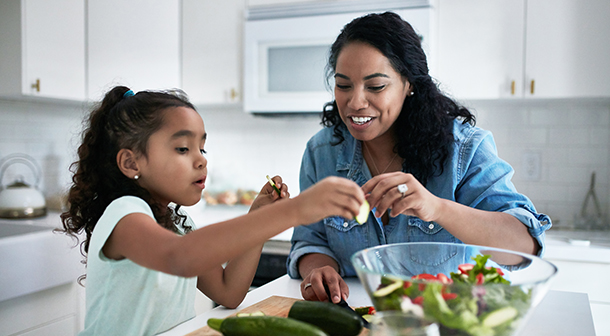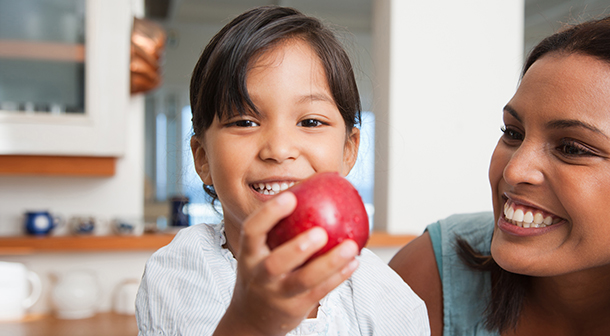Healthy Meals for Kids
By Elizabeth McBride
Read Time: 10 Minutes
It's not easy coming up with healthy breakfast, lunch, and dinner ideas for kids, day in and day out. When you add the special nutritional requirements of healthy meals for toddlers and infants and satisfying the demands of a picky eater, planning healthy meals can start to feel a little overwhelming.
Don't worry. You've got this. You can raise kids with healthy eating habits and take the stress out of mealtime. Keep reading to get tips and ideas to make healthy, kid-friendly meals.

Nutrition matters at every age.
There's so much advice on nutrition, and so many fads and do's and don'ts. They're always popping up on social media feeds, and sorting through all that information can be overwhelming and confusing. So, it's important to look at what doctors recommend, not the claims of the latest trend.
For one thing, don't be too worried about your child's weight. Focus on nutrition and exercise. Children go through growth spurts and weight changes are part of that. If a kid is active and eating a good variety of foods, then they are probably doing just fine. If you or your child is worried about his (or her) weight, talk to his doctor before making any changes to his diet. If you think your child has an allergy or a sensitivity to a certain food, such as gluten or dairy, for example, talk to your doctor before cutting that food out of his diet.
Good nutrition is critical to your child's mental and physical development. Below is an overview of what kids need at every age:
Babies (up to 1 year)
Breastmilk or formula provides most of the nutrition babies need for their first year. Starting solid foods such as iron-fortified infant cereal and pureed fruit, vegetables, and meats at age four to six months helps to supplement the iron and zinc that breastmilk may lack. Avoid low-fat versions of foods like yogurt and cheese. Babies need healthy fats for brain and nerve development. The American Academy of Pediatrics recommends no cow's milk until after the first birthday as it can cause allergic reactions, diarrhea, and vomiting.
Toddlers and preschoolers (age 1-5 years)
Kids this age go through growth spurts, and they will eat accordingly. It's normal for them to eat a lot one day and not much the next. Below are some toddler food ideas and tips.
- This age group can be especially picky about what they eat. Choose your battles and focus on making sure they are getting enough calcium and fiber. Calcium builds strong bones and teeth. Fiber has a lot of health benefits, but it's especially good for toddlers who tend to prefer bland, starchy foods like chicken nuggets and mac and cheese. Fiber aids in digestion and prevents constipation.
- Milk (or milk alternatives that are calcium-fortified) are a great source of calcium. Other calcium sources are tofu, calcium-fortified orange juice, cereals, waffles, and oatmeal.
- Fruits, vegetables, beans, and whole grains are great sources of fiber.
Grade-schoolers (age 6-11 years)
Focus on providing a wide variety of healthy kid foods. As your child grows up, he will naturally gain more independence (and opinions) about the foods he eats. Empower your child to have healthy eating habits by teaching him which foods will help him feel good and make him healthy and strong. An easy way to teach your child about kid nutrition is by talking to him about Go, Glow, Grow, and Whoa foods.
- Go foods. These are the foods that give kids energy to jump, run, and play. Examples of Go foods are pasta, potatoes, rice, and bread.
- Grow foods. These foods help their body grow bigger and stronger by building bones, teeth, and muscles. Examples of Grow foods are chicken, meat, fish, eggs, milk, cheese, and yogurt.
- Glow foods. These are colorful fruits and vegetables that are full of vitamins and minerals to keep skin, hair, and eyes bright and glowing. They also keep kids' immune system strong so they can stay healthy and recover faster when they get sick.
- Whoa foods. These are foods such as salty snacks and sugary treats. Teach your child that Whoa foods are okay to eat sometimes. Too many Whoa foods can cause weight gain and low energy.
Need parenting help now?
The Texas Parent Helpline is available 24/7.
- Call 833-680-0611
- Chat with us
- Text 833-680-0611
Preteens and teens (age 12-18 years)
Teens grow fast, which means more calories are needed to keep up with all their body changes. It's common for hungry teens to reach for high-calorie foods with little nutritional value, like sugary drinks and fast food. Make sure they're still getting the nutrients they need by watching out for Whoa foods and focusing on those Go, Grow, and Glow foods. Too many Whoa foods could lead to diabetes.
Make sure your teen is getting these nutrients:
- Calcium. Calcium is key because this age is when most of your child's bone mass is built. Encourage him to eat foods rich in calcium such as milk, milk products, or calcium-fortified milk alternatives.
- Iron. Teen girls will need more iron to replace what they lose during menstruation. Good sources of iron are:
- Lean meat, turkey, and chicken
- Beans and lentils
- Tofu
- Baked potatoes
- Cashews
- Dark green leafy vegetables such as spinach
- Fortified breakfast cereals
- Whole-grain and enriched breads
- Protein. Teen boys need slightly more protein than girls. Chicken, meat, fish, peanut butter, nuts, eggs, and dairy products are good sources of protein.
Combine a plant-based source of iron with vitamin C for better iron absorption. Examples: spinach with lemon or iron-fortified cereal with berries.
Build healthy eating habits.
If you have young children, you are in a great position to build healthy eating habits from the start. But it's never too late to get older kids on board too. Find time to talk to them about how it's possible to create healthy eating habits.
- Discuss the best options for a healthy school lunch, whether in the school cafeteria or when eating out with friends.
- Talk to him about what his body needs to perform at its best.
- Ask him how he feels after eating sugary foods or fast food versus when he makes a healthier choice.

Tips for encouraging kids to eat healthy foods
- Don't forget to encourage Go, Grow, and Glow foods.
- Don't forbid certain foods. When a food is labeled as being bad it can sometimes make it even more enticing and lead to craving and overindulging. It's better to try to limit unhealthy foods.
- Add a fruit and vegetable to every meal. You can introduce them by:
- Having plenty of washed and prepped fruits and vegetables ready to go. Leaving a fruit bowl with bananas, apples, and oranges makes it easy for kids to grab and go.
- Encouraging younger children to eat from every color of the rainbow. See how many colors you can get into one healthy, kid-friendly meal.
- Adding diced vegetables into dishes like lasagna, tacos, or spaghetti sauce.
- Being a good role model. Eat your fruits and veggies so your kids are more likely to follow your lead.
Cook more meals at home.
When you do the cooking, you can ensure your family is getting a well-balanced meal. You can choose to grill instead of fry, hold the butter and/or salt, increase the veggies, and make any other changes that make sense for you and your family. Eating at home gives you a lot more control over your kids' nutrition, and depending on what you choose to cook, you'll likely save money too. Eating meals together is also a great way to connect as a family.
Get kids involved in shopping for groceries and preparing healthy meals.
Giving kids some control by making them part of the process is a great way to get them on board with healthy eating. As you're shopping and cooking with your child, talk to him about where the food comes from and whether it was grown on a farm or made in a factory. Show him how he can look at the labels to find out what's in the foods he eats.

Watch the sugar.
Sugar is hiding in all sorts of things you might not normally think of as sweet such as bread, pizza dough, pasta, canned foods, and cereal. The American Heart Association recommends that children limit sugar to 3 teaspoons a day. Check the amount of sugar per serving on the food labels. Too much can cause spikes in blood sugar, which can mean changes in your child's energy and mood. Excessive sugar can also lead to long-term health problems like childhood obesity and type 2 diabetes.
Limit sugary drinks.
A soda can have 10 teaspoons of sugar. Offer water or low-fat milk instead of drinks with added sugar. Even juice can have a lot of natural sugar or added sugar. Consider diluting juice with water to decrease the amount of sugar per serving.
Serve appropriate portion sizes.
MyPlate is an updated version of what you may remember as the food pyramid. It's a great way to meet your kid's nutrition needs with the right portion sizes and food categories.
Allow kids to serve.
As soon as children are able, let them serve themselves at the table. Let them know it's okay to ask for more if they're still hungry. Remind them that they should listen to their body to determine whether they're full.
Fuel with healthy snacks.
Make sure your kids have the energy they need throughout the day. Aim for two food groups in each snack. A good snack might be:
- Apples and peanut butter
- Cheese and carrots
- Hummus and bell pepper
Need healthy snack ideas?
Think outside the box. A good way to cut back on processed snacks and ones with added sugar is to avoid food that comes in a box or a bag. If it can stay on a shelf for months or even years, it's probably not a healthy snack.
5 Tips for dealing with picky eaters
Having a picky eater can be frustrating. Never turn a meal into a battle of wills. Forcing a child to try a food or punishing him for not eating is never the answer. Here are a few positive ways to cope:
- Plan healthy meals with at least one item that everyone will eat.
- Be patient. It can take a number of tries before a child accepts a new food.
- Take your picky eater to the grocery store. Have him pick out produce and other healthy foods he wants to try.
- Let your kids help with the cooking. Even picky eaters will often want to try what they have helped make.
- Don't worry about a clean plate. Teach your children to pay attention to their hunger cues and stop eating once they're full.
Plan healthy meals and snacks in advance
Healthy meals and snacks don't have to be complicated or fancy. If you enjoy being adventurous in the kitchen, then by all means go for it, and include the kids in the fun. But when you just need to get a healthy meal on the table fast, planning your meals ahead of time will help you avoid heading to the nearest drive-thru.
Try these healthy breakfast ideas for kids
- Oatmeal with berries. Look for no-sugar-added, plain oatmeal as opposed to the flavored kind, which can have a lot of extra sugar. Sprinkle with cinnamon for flavor without the added sugar.
- Scrambled eggs with toast and fruit. For a quick breakfast, try scrambling eggs in the microwave! Just crack an egg in a mug with a little milk, stir, and microwave.
- Fruit and yogurt smoothies. For a speedy, simple breakfast idea try this smoothie recipe for kids. Blend your favorite frozen fruit, milk, and yogurt in the blender until smooth. Add chia seeds and flaxseed meal for added fiber and nutrients.
- Whole grain, low-sugar cereal with low-fat milk.
Healthy lunch ideas for kids
- Cheese quesadilla with guacamole and veggie sticks.
- Hummus with pita and olives. Serve with cucumber and carrots for dipping.
- English muffin pizzas. Spread pizza sauce on English muffin halves and top with cheese and veggies. Bake at 450°F until cheese is melted.
Healthy dinner ideas for kids
Go with what they love.
Which fruits, vegetables, proteins, and whole grains does your family tend to like? Build meals around those. For example, if your family loves grilled chicken and you know your children will eat broccoli, start there. Add a Go food like rice or a baked potato. Most children like simple dishes instead of things with fancy sauces. So, keep it simple and make things your family likes.
Build-your-own tacos.
Swap ground turkey for ground beef for a healthier version. Use your favorite taco seasoning and add finely diced veggies to the ground turkey or beef to sneak in extra veggies.
Pasta salad.
Cook pasta according to the directions on the package. A few minutes before the pasta is done, add veggies like cauliflower, broccoli, and sugar snap peas. Drain the veggies and pasta and add Italian dressing and any other items you and your family enjoy. Sliced olives, cubed mozzarella, sliced salami, marinated artichokes, and roasted red peppers make yummy additions!
Tonight's leftovers can be tomorrow's lunch. Plan ahead by making extra.
Plan theme nights.
Kids like routines. Even teens enjoy knowing what's for dinner so they can look forward to a good meal at the end of the day. Consider creating themes for every night of the week. You can still vary the dishes you serve, but the theme will help you quickly plan and give your kids something to look forward to.
Themes for a week's worth of kid-friendly dinner ideas:
- Meatless Monday
- Taco Tuesday
- Italian Night Wednesday
- Stir-fry Thursday
- Pizza Friday
- Sandwich Saturday
- Souper Sunday
Make a plan.
With some planning, you can map out a week or even a month's worth of healthy dinners for kids.
- Take a look at your calendar and note any activities, such as a late meeting or practice, that might make getting dinner on the table difficult. If you have a slow-cooker, consider using it for days when you need dinner ready as soon as you walk in the door.
- Add healthy family dinner ideas to your calendar. If you use a digital calendar, consider linking directly to any recipes that are online. From the recipes, you can copy and paste ingredients into a grocery list. If you prefer pen and paper, a handwritten list and paper calendar work just as well.

Healthy recipe idea for kids
Most kids love chicken tenders. Here's a healthy version to try.
Oven-Fried Chicken Tenders
Ingredients
- 1/4 cup flour
- 1 egg, beaten
- 1 tablespoon water
- 1 cup plain or Italian-style bread crumbs
- 1/2 cup grated Parmesan cheese
- 1 1/4 pound chicken breast tenders
Steps
- Heat oven to 425°F. Line a cookie sheet with foil and spray the foil with cooking spray.
- Line up 3 separate shallow dishes - one for the flour, one for the egg and water mixture, and one for the breadcrumb and cheese mixture.
- Coat chicken with first with the flour, then the egg mixture, then with bread crumb mixture. Place coated chicken on the cookie sheet.
- Bake chicken 15 to 20 minutes, turning after 7 minutes.
Quick reminders
- Know what your child needs to eat to build a healthy mind and body.
- Make it easy for kids to grab fruits and veggies on the go.
- Serve a fruit or vegetable with every meal and snack.
- Plan your meals in advance around your family's schedule.
- Make it fun with theme nights!
- Get your kids involved with the cooking and planning.




